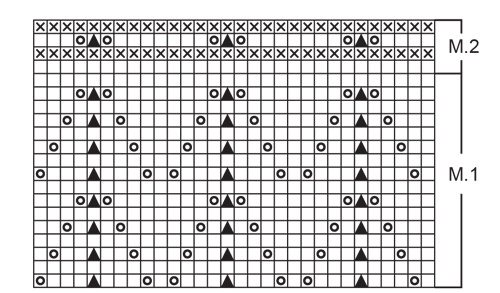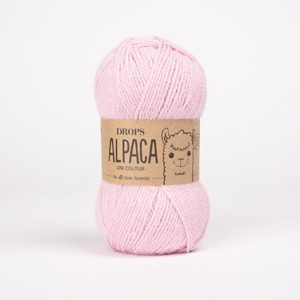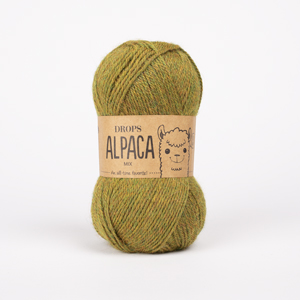Comments / Questions (37)
![]() Eva wrote:
Eva wrote:
Ska det stickas på strumpstickor hur stickar man från avigsidan då???
14.05.2025 - 11:35DROPS Design answered:
Hej Eva. Ja pulsvärmarna stickas runt på strumpstickor så alla varav stickas från rätsidan. Mvh DROPS Design
14.05.2025 - 13:21
![]() Ingela wrote:
Ingela wrote:
När man minskat från 60 till 50 maskor ska man ju börja med mönster M1. Men mönstret visar 30 maskor - alltså totalt 60 maskor? Förstår inte riktigt hur det är tänkt. Ytterligare en fråga: visst ska man läsa mönstret från höger till vänster? Jätteglad för hjälp!
05.11.2024 - 19:10DROPS Design answered:
Hej Ingela. Ja det stämmer att du läser mönstret från höger till vänster, nedifrån och upp. När du har 50 maskor och ska sticka diagram M1 så stickar du först hela alla 30 maskor i diagrammet och efter det börjar du om men då stickar du bara de 20 första. Mvh DROPS Design
06.11.2024 - 07:14
![]() Magnhild Grimastad wrote:
Magnhild Grimastad wrote:
Hei Holder på og prøve meg på disse. Jeg har 50 masker på pinnen etter felling i starten. Gikk ut fra at det skulle jg ha til arbeidet var ferdig. Men nå blir det en maske mindre for hver omgang m mønster. Hva gjør jg feil?
30.05.2024 - 09:38DROPS Design answered:
Hei Magnhild. Har du husket alle kastene? På 1. omgang strikkes det over 50 masker slik: 1 rett, 1 kast, 3 rett, ta 1 m løs av som om den skulle strikkes r, 2 r sm, løft den løse m over (=1 maske), 3 rett og 1 kast. Dette gjentas 4 ganger til. mvh DROPS Design
03.06.2024 - 09:46
![]() Sabine wrote:
Sabine wrote:
Können Sie bitte folgenden Satz korrigieren: „ Wenn die Arbeit eine Gesamtlänge von 20 cm hat - daran angepasst, dass 1 ganzer Rapport anpassen gestrickt wurde.“ Es muss heißen: „... daran angepasst, dass 1 ganzer Rapport gestrickt wurde.“, das Wort „anpassen“ ist zuviel und verwirrt ungeübte Strickerinnen. . Die englische Version ist richtig. Ich finde in einer „komplett neu formulierten“ Anleitung, die so kurz ist, sollten solche Fehler nicht passieren.
01.05.2022 - 16:58DROPS Design answered:
Liebe Sabine, vielen Dank für Ihre Rückmeldung. Auch wenn wir uns um Sorgfalt bemühen, kann sich der Fehlerteufel leider immer mal wieder einschleichen, selbst wenn die Anleitung kurz ist. Wir freuen uns dann, wenn sich aufmerksame Menschen wie Sie die Zeit nehmen, uns auf Fehler und/oder verwirrende Formulierungen hinzuweisen. Die Anleitung wurde nun korrigiert. Viel Spaß beim Weiterstricken und beim Tragen Ihrer neuen Pulswärmer!
02.05.2022 - 10:57
![]() Pamela Große Heitmeyer wrote:
Pamela Große Heitmeyer wrote:
Hallo, Ist das denn richtig das sich das Muster nach rechts dreht woe eine Spirale am Anfang? Das sieht so aus als wenn sich das Muster in einer spirale hoch schlängelt obwohl ich es genau so stricke wie auf dem Rapport angegeben von rechts nach links lese ich es ich möchte gerne meinen Fehler finden bei jeden klappt es nur bei mir nicht liebe Grüße
12.04.2022 - 08:30DROPS Design answered:
Liebe Pamela, vielleicht probieren Sie Folgendes: Statt direkt den Pulswärmer in Runden zu stricken, stricken Sie als Probestück einen einzigen Muster-Rapport hin und zurück, um ein Gefühl für das Muster zu bekommen. Sie sollten am Anfang und am Ende ein paar Maschen kraus rechts stricken (d.h. Sie können z.B. 20 M anschlagen und wie folgt stricken: 5 M kraus rechts, 1 Markierungsfaden setzen, 1 Muster-Rapport (= 10 M) stricken, 1 Markierungsfaden setzen, 5 M kraus rechts). Vielleicht entdecken Sie auf diese Weise, warum sich Ihr Muster spiralförmig dreht. Beachten Sie, dass Sie dann die Rück-Reihen von links nach rechts lesen.
13.04.2022 - 11:23
![]() France wrote:
France wrote:
La grille est fait pour 60 mailles au lieu de 50
11.04.2022 - 22:29
![]() France wrote:
France wrote:
Après les diminutions, il me reste 51 mailles au lieu de 50. Est ce normal? Merci à l’avance
11.04.2022 - 22:17DROPS Design answered:
Bonjour France. La répétition du diagramme est de 10 m. Le diagramme se tricote sur les 50 m.
15.04.2022 - 19:31
![]() Pamela Große Heitmeyer wrote:
Pamela Große Heitmeyer wrote:
Hallo nochmal, Wenn ich das Muster stricke Dreht sich das ist das normal? und sieht auch gar nicht so aus wie auf dem foto ich habe da irgendwie ziemliche probleme mit. Ich fange an mit : 1 re ,1umschlag 3re, dann eine woe zum re stricken abheben 2 zus. Und die gehobene drüber ziehen ,3re, 1umschlag,1re 1umschlag 3re und immer so weiter ist da vllt schon ein Fehler drin ? Liebe Grüße
11.04.2022 - 08:49DROPS Design answered:
Liebe Pamela, so wie Sie das Muster beschreiben, ist es korrekt und "auf die Ferne" ist kein Fehler erkennbar. Vielleicht versuchen Sie, sich jeden einzelnen Rapport mit einem Faden zu markieren (also immer nach jedem 2. Umschlag, bezogen auf die 1. Muster-Reihe), sodass Sie genau sehen, wo ein Muster-Rapport beginnt und aufhört.
13.04.2022 - 11:11
![]() Pamela wrote:
Pamela wrote:
Super vielen Dank für die Antwort nur komme ich mit noch etwas nicht zurecht und zwar nach den 10 Maschen im Rapport pro mustersatz ende ich dann immer mit einem Umschlag? Sonst habe ich entweder immer Maschen zu wenig oder zu viel auf den Nadeln ? Also 10 M stricken und dann geht es auf der anderen nadel mit einem Umschlag weiter? Liebe Grüße
07.04.2022 - 18:31DROPS Design answered:
Liebe Pamela, ja genau, 1 Muster wird über 10 Maschen gestrickt, und nach der 1. + 9. Reihe enden Sie mit 1 Umschlag, dh 1. Reihe =*1 re, 1 Umschlag, 3 re, 1 M. re. abheben, 2 re. zusammen, die abgehobene über die gestrickte ziehen, 3 re, 1 Umschlag* = 10 M. von *bis* insgesamt 5 Mal stricken = 50 Maschen. Viel Spaß beim stricken!
08.04.2022 - 08:34
![]() Pamela Große Heitmeyer wrote:
Pamela Große Heitmeyer wrote:
Hallo liebes drops Team, ich habe eine Frage in dem Diagramm sind ja 30 M abgebildet laut muster ich habe aber 50 M auf der Nadel wie stricke ich das denn nun ? Da komme ich irgendwie nicht weiter liebe Grüße Pamela
07.04.2022 - 10:22DROPS Design answered:
Liebe Pamela, nach den 30 Maschen im Diagram stricken Sie dann die ersten 20 Maschen im Diagram, so haben Sie insgesamt 5 Muster mit einem Lochmuser im Dreieck und 50 Maschen. Viel Spaß beim stricken!
07.04.2022 - 12:21
DROPS 86-3 |
|||||||||||||
|
|
|||||||||||||
DROPS Wristwarmers in Alpaca
DROPS 86-3 |
|||||||||||||
|
Pattern: See diagram (pattern 1 and 2) below. The pattern is seen from the right side. Wristwarmer: Cast on 60 sts evenly distributed on double-pointed needles; join and place a marker at the join. Knit 4 rows garter st. Establish pattern on the next row as follows: K 5, sl 1, K 2 tog, psso, *K 9, sl 1, K 2 tog, psso*, repeat *-* 3 more times and finish with K 4. You have decreased 10 sts = 50 sts. K 1 row, then knit Pattern 1. When the piece measures 20 cm – adjust to end after 1 entire repeat – knit Pattern 2 and then cast off all sts. The piece measures approx. 21 cm. Knit a second wristwarmer. |
|||||||||||||
Diagram explanations |
|||||||||||||
|
|||||||||||||

|
|||||||||||||
Have you finished this pattern?Tag your pictures with #dropspattern or submit them to the #dropsfan gallery. Do you need help with this pattern?You'll find 13 tutorial videos, a Comments/Questions area and more by visiting the pattern on garnstudio.com. © 1982-2025 DROPS Design A/S. We reserve all rights. This document, including all its sub-sections, has copyrights. Read more about what you can do with our patterns at the bottom of each pattern on our site. |
|||||||||||||























































Post a comment to pattern DROPS 86-3
We would love to hear what you have to say about this pattern!
If you want to leave a question, please make sure you select the correct category in the form below, to speed up the answering process. Required fields are marked *.